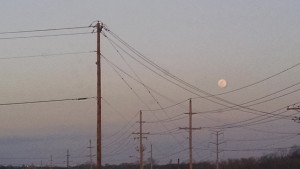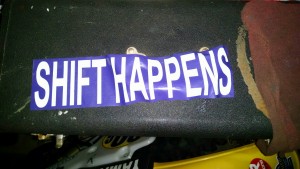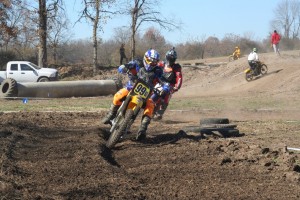
Tag Archives: trust
When to laugh, when to just say no, 
When to keep, when to let it go,
When to hope, when to let it die,
When to sleep,when to dry your eye,
When to climb, when to settle down,
When to play, when to dance around,
When to see, when to close your eyes,
When to be in darkness, when to soar, to fly
Chorus:
I don’t know the answers to these questions
But I know that if I open up my heart,
It will be
I don’t know the answers to these questions
But I know that if I open up my heart,
It will be
Had an article all queued up two weeks ago for this last Thursday in 2015: all about the uselessness of worry. Then life served up a chance to practice what I was preaching.
St. Louis saw record rainfall earlier in the week. This photo is my front yard on Monday. On Sunday, the lake my home sits on breached its containment, and the watch ensued. Levels held pretty steady until about 3 a.m., and from there the water steadily rose. 
By 10 a.m. on Monday morning, the lake seemed close to crest, still needing another foot plus to reach my basement. Feeling pretty confident that my neighbors and I had bested the worst of the storm, I went downstairs to exercise a bit.
Well, well, well. What have we here? When I reached the bottom of the steps, the carpet splashed. So even though the water hadn’t reached the exterior level of my basement, the sewer system supporting these low-lying homes couldn’t handle all the water, and it was tumbling up out of my basement drain.
Pretty sure there was one f-bomb, then to work. First I put soup cans somebody gave me under the legs of a table I’d made, and put my drum kit on top of that. Next was the P.A. system up the steps. Then albums and all sorts of stuff where stacked on metal chairs. Lastly, boxes of CD’s and books were taken upstairs.
Eventually, the drain started acting right, and water went back underground. I used a sheet of plywood like a big ole’ squeegee, and pushed water to the drain. Thankfully, the basement is not finished, so only the carpet at the bottom of the stairs was soaked. In time, I hosed down the little sewage that came up, hit the carpet with a shop vac, dried the whole thing with fan and heater and lastly did some disinfecting.
Who knew life was gonna offer up an occasion to experience myself in higher stress. And while my mind wanted to spin scary stories, it didn’t. And that was the whole point of the original article about the uselessness of worry. Unless we’re being chased by a dog or somehow seriously threatened, worry is useless.
Worry cops our energy. It weakens our focus. It steals oxygen from the brain, making clear communication and thinking difficult.
So why do it? Worry can be companion to a mind hooked on overactivity. Worry can give a place for anxious energy to land. Worry can also give us a a sense of self, albeit a broken one. When you think about it, worry begins to sound somewhat self-involved.
So if you care to, please join me in leaving any habit of worry in 2015.
Here’s a three step process to help:
Step 1. Get familiar with your worry. Notice when it’s beginning and ending. Your body can help with its Stress Activated Signals (S.A.S.). These signals include things like ears getting hot, tightness in chest, sweaty palms, choppy sentences and stomach upset.
Step 2. Recognize in this moment of worry, you have the following choices: fight the situation, get away from it, freeze with fear, or flow by taking the next right step, trusting the step after that will be clear once you take the next right step.
Step 3. Choose*
*Consistently, the flow response has proven to be for me the most effective, efficient and comfortable way to react to worrisome situations. It’s also the one that comes with the most peace.**
**May peace visit those whose homes and livelihoods have been seriously compromised by the flood.
Hope is like cornering: lean in a little and let go. Otherwise you interfere with the flow of things.
Racing has taught me a lot. If you train your eyes on some nasty cross-rut or rock in your line, that’s exactly where your body takes you and the bike. Next thing you know, you’re down and picking up parts.
But if you focus instead on where you want to go, your body takes you and the bike there. Somebody once told me about a guy on a motorcycle at a crossroads in the Branson area. The biker decided to shoot between oncoming vehicles. Unfortunately, traffic was too fast and a car clipped the motorcyclist.
Here’s the telling piece. When you looked at skid marks left by the car, the dark lines curved right into the biker! The car driver did exactly what most of us would have done: set his eyes on the darting motorcycle. But, had the driver of the car looked instead at where he wanted to go (straight ahead) he would likely have missed the biker. Where we focus is where we go.
Biking has also taught me about hope, and it’s a lot like cornering. To corner, it’s best to simply shift your weight into the corner and then let nature takes its course. Relatively effortless, actually. But it’s easy to overthink and oversteer. The result: you get off course.
Life’s like that. Hope seems to serve us best when we gently point our hearts in the direction of what we want, and then let go. After that initial setting of direction, if we overthink it, or focus too much on getting what we originally hoped for, our actions get skewed and the natural course of things can no longer flow.
In this way, hope seems to engender a little trust.
When we’re madly in love, it’s all good. Or so it seems. When we’re madly in fear, what felt like love now just feels like madness. Here are some thoughts about distinguishing the madly in love from the madly in fear.
We all have two needs: the need to be connected and the need to be separate. Behind each of these two needs is a fear. Behind the need to be connected is the fear of being over-connected or engulfed. Behind the need to be separate is the fear of being over-separated or abandoned.
When you are healthy, your relationships reflect that health. And healthy means you balance your need to connect and your need to be separate. So does your lover. Your choice of lovers mirrors all that’s wonderful about you and all that’s wounded. In keeping with this mirroring, healthy lovers mutually recognize and honor both needs for connection and for separateness. That same mirror also reflects any fears.
“Madly in love” usually becomes, “in love,” which may for some evolve into simple, healthy “love.” Healthy love has its ups and downs, but doesn’t reach the extreme swings in thoughts, feelings and actions that we’ll talk about later. In healthy love, there are real differences. And sometimes that means intense conversation. But respect for the other remains in tact and trust remains unbroken.
Healthy love feels comfortable even if the object of your affection is out having a good time without you. Healthy lovers may actually enjoy time being separate from the other. And there’s no preoccupation wondering what your lover thinks if you take time for yourself. That’s because you trust that person to take care of him or her self. And that person trusts you and what you do with your time.
So those are thoughts about healthy love and the need for separateness. The other half of the equation is how you respond to your need for connection. In healthy love, you feel safe moving toward the object of your affection, because you know, first of all, that your lover is happy to receive your connection. Secondly, you know that if one of you needs space when the other needs contact, you (as an act of love) will either accept the other’s need for connection, or will honestly express the need to be more separate. All of this is done in a spirit of respect. It’s actually pretty straight forward. No heaviness. No deep talks. And respect is a product of trust, which emerges as a central quality in healthy love. However, in unhealthy love, trust is lost in fear.
Unhealthy lovers feel just the opposite when separate from their love interest: “What’s my love doing?”; “Who’s my love with?”; “Is my love thinking about me?”; “Does my love have as much fun with me as he/she does with that other person?” These are unhealthy thoughts related to madly in fear of abandonment and these are the hallmarks: suspicion, neediness, things are never quite enough, trying too hard, over-giving, and holding on with clinched fists.
The other primitive anxiety spoken about above is madly in fear of engulfment: “I can’t breathe in this relationship anymore.”; “There’s always an issue.”; “I’m not attracted to you.”; “Grow up.” Rage, disrespect, disengagement, giving up, pushing away: these are attempts to create distance from the pursuing partner, and hallmarks of the madly in fear of engulfment.
Soon the madly in fear dance begins: one person backs away, the other pursues. The one pursuing feels hurt and the one pursued feels cornered. The passion and play and pleasure and flow of the original relationship have turned into one sand trap after another. Everything seems bogged down and weighty and flat-out scary. Of course, it takes two to tango, and eventually the one pursuing stops, leaving the pursued feeling alone, and the step flips. Dang.
If you think fondly of your love, and even long for that person, but feel comfortable by yourself and, yes, comfortable in the presence of your lover, you’re probably healthy in love. If you feel uncomfortable and anxious away from your lover; uncomfortable, judgmental or highly self-conscious around your lover, you’re probably crazy in fear.
The way out: pay attention to your own fear, not your lover’s stuff. Own that your lover is not causing your fear. It’s yours to shift. If you both take responsibility for your own fear, you might just create love.
New York Times bestseller, Gary Zukav, introduced me to the love/fear paradigm years ago through his book, The Seat Of The Soul. It’s become clear to me, after 35 years counseling folks in all kinds of pain, that , more often than not, we are walking in either a state of love or a state of fear. Thank goodness, shift happens.
Trust, peace, tenderness, openness, gratitude, kindness, and healthy power: these are all emotions born of an inner experience of love.
Doubt, anxiety, anger, confusion, discontent, bitterness, rigidity, impatience and unhealthy power: these are all emotions born of an inner experience of fear.
Love and fear, like all emotions, are just that–emotions. Period. One emotion is no better than the others. All are just sign posts on the journey of our lives.
But here’s the important difference between those emotions in the love category and those emotions in the fear category. Those emotions born of an Innernet of love make us feel good. Those emotions born of an Innernet of fear make us feel bad.
By the way, I refer to these two states as Innernets because these core emotions have a measurable effect on a core aspect of our brains, the neuronets.
So while no emotion is bad, all emotions have a good or bad impact on how we feel, which affects our hormones, neuropeptides and neuronets. And this has a good or bad impact on our bodies.
Fundamentally, what helps us and our bodies most is to experience whatever emotion shows up and then gradually shift ourselves to an Innernet state that feels good or better.
This shift is not about thinking. To access an Innernet state that feels better, you have to deal with feeling.
So here’s a quick, three-step technique to make Shift Happen:
- Ask yourself regularly, “What’s my core feeling: love or fear?”
- Ask yourself, “Does this core feeling serve me right now?” Sometimes we are given guidance by our anger, sadness or fear. As a result, sometimes it’s important that we experience those emotions.
- If your core emotion right now does not serve you, gently shift what you experience at a core level, in your gut, to a feeling more like love.
In making Shift Happen for yourself, it’s important that you gauge the shift with your gut and not your mind. Your body can help here. Your body has ways of telling you that you are moving into an Innernet state of love: breathing slows, face relaxes, stomach quiets, and body movements become more fluid, just to name a few.
If you’re having trouble creating a shift in yourself to loving kindness, it’s OK. Be gentle with yourself. Don’t force or wrestle yourself into a state that feels better. Simply set an intention regularly to feel more of this inner goodness, and then invite that better feeling when you can. Again, the real shift happens at the emotional and physical level. To truly make a shift in this way requires fundamental shifts in body chemistry and form. This can take time. Please be patient with yourself.
If it helps, try going for the feeling you have when you’re in the arms of someone you love. Again, the feeling matters more than the thought. Or go for the feeling you have when holding a baby, or a puppy. Thoughts can take you there, but the destination we’re after is the feeling. Let your whole self and body bask in this feeling. Then Shift Happens.
“Hope is like a path on the hillside. Once there was no path, but as villagers traveled that place, a way appeared.” Those beautiful words by Lin Yutang were written well before our current understanding of neuropaths and neuroreceptors. And yet they perfectly describe what happens in the brain and on the surface of the cells, as we open ourselves more and more to hope, or any emotion. Here’s how it works.
Endorsed by two New York Times bestselling authors.”


